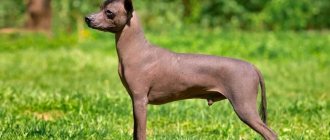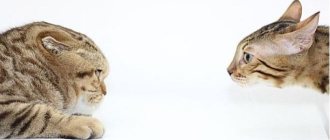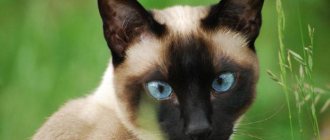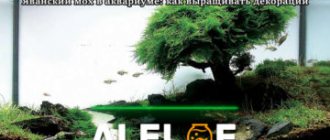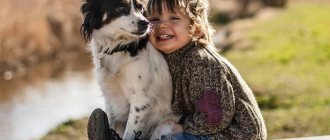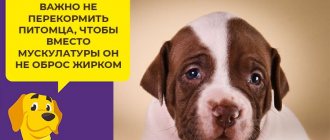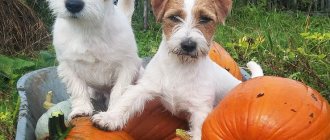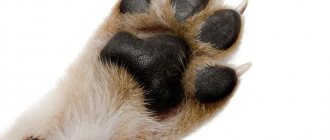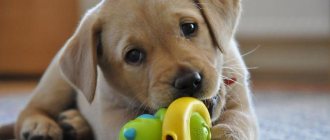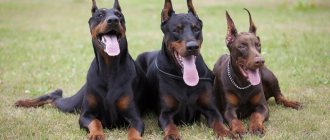Pit bull mastiffs are dogs that have an undeservedly bad reputation. People are afraid of these animals, consider them unreasonably aggressive and very dangerous. The descendants of these dogs have fighting roots - this served to create the stereotype of uncontrollable bloodthirsty pets.
Interest in this type of dog has recently grown due to the fact that pit bull mastiffs are included by legislators in the “List of Potentially Dangerous Dog Breeds.” These dogs must be on a leash and muzzle when appearing in public places, and their presence on the territory of a private home must be indicated by a warning sign.
What exactly is a Pitbull Mastiff dog? Does such a breed exist? What types of pit bull terriers and mastiffs can you find? What do these controversial animals look like and are they characterized? You can find answers to all these and other questions about this type of dog in our material.
Pit bull mastiffs - does such a breed exist?
If you refer to international canine standards, study them carefully, you will not find the pit bull mastiff dog breed there. There are breeds there: bull terrier, bullmastiff, mastiff, American pit bull terrier, American Staffordshire terrier. Mastiffs, by the way, have many varieties in the standards: Spanish, English, Major, Tibetan, Neapolitan and Pyrenean.
Can't you find why? Because there is no standard for the Pitbull Mastiff breed! It is not included in any international classification. There is no standard, but there are dogs! And even included in some lists. Next we will look at what a pit bull mastiff looks like, what kind of dog it is and what kind of character it has.
Important: you can often come across the statement that pits (the American pit bull terrier breed) do not have an official Standard. This is wrong! Pit bulls are recognized by three canine organizations - ADBA, UKC, AKC.
American Pit Bull Terrier
History and characteristics of Amstaff
Amstaffs are an artificially bred variety of fighting dogs, based on those species that settled the soil of America in the early nineteenth century along with their owners from different parts of Europe.
Initially, all four-legged fighters were called nothing more than pit bull terriers, without distinguishing them by individual characteristics. It was only in 1936 that the breed was officially identified, and in 1972 the final name was formed.
The man who made his important contribution to the creation of a separate species was named Wilfred Brandon. It was he who first identified the main differences between our heroes and other fighting-type pets and, on their basis, registered the first standards in 1935. He is also the President of the American Staffordshire Terriers of the United States of America. The Fédération Cynologique Internationale included Amstaffs in its registries in 1936. It was only in 1971 that the final standard was officially approved.
Staffords combine completely contradictory characteristics and this is what attracts most owners. In appearance, a small dog should inspire a feeling of power, strength and invincibility.
Just the sight of it is enough to feel danger and threat, but at the same time this creature is infinitely devoted to its owner, in need of communication with him, affection and praise. They have a highly developed instinct of self-preservation, but meanwhile legends are made about their courage. Willfulness, strong will and stubbornness are easily combined with the desire to please its owner. If you have decided to get a fighting breed dog for the first time, then you should give up the Amstaff.
Training will take a lot of time and require a lot of effort and patience even from an experienced dog breeder, and a beginner will most likely simply not cope with such a task.
Current standard:
- the muzzle should not be too long or too short. The transition to the frontal part is quite sharp,
- The dorsum of the nose is rounded. The tip is necessarily pigmented black,
- The ears are located high on the top of the head. In a natural, undocked state, they should rise slightly on the cartilaginous part. Completely drooping ears are considered a fault.
- massive jaws, clearly prominent cheekbones,
- the eyes are small, round, set high and widely spaced,
- lips are thin, tense, should not hang down,
- the torso is toned, massive, muscular,
- limbs should not be long or too short. The forelimbs are spread wide apart
- the chest is wide and well developed,
- proportions must be observed in the relationship between body weight and height. The average height is forty-seven centimeters,
- Almost any color is allowed, except plain white and black.
Dog breed Pitbull Mastiff - a cross between a pitbull and a mastiff
Yes, dogs that are called that way are mestizos, hybrid animals. A detailed description of this mix is not often found on Russian-language sites, but in the English-speaking space there is a lot of material about such pets.
There are several common names for these hybrids:
- pit mastiff;
- American suit bull;
- bullmastiff pitbull mix;
- American bandoggy.
These could all be different dogs, because there are a lot of options for crossing similar breeds. The American Pit Bull Terrier can be bred with the Neapolitan Mastiff, with the Bullmastiff, with the Mastiff.
What does a hybrid look like?
Due to the fact that breeders have many options for crossing and obtaining mixed breeds, it is impossible to describe in one word what Pitbull Mastiff dogs look like. The appearance of the hybrid in each specific cross will depend on what its parents looked like.
One thing is for sure - this is a fairly large, muscular animal with a stocky build. Mixed breed males can reach 63-74.5 cm in height and weigh from 45 to 63 kg. The females of this cross-breed are somewhat smaller, but also impressive in size. Given the active nature of the breed, you should not get such dogs if you do not have enough space.
The coat color of mixed breeds can also vary greatly. The color of a mix puppy is influenced by the coat color of its parents. Most likely color options:
- black pitbull mastiff;
- white;
- red (usually red pit bull terrier puppies);
- brown;
- brindle.
In addition to these pure colors, combination color options are possible - a mixture of the above colors. Some individuals have a characteristic “black mask”.
The structure of the wool of hybrids is thin and short with a low or moderate level of shedding. It is not difficult to care for such fur; it is enough to comb your pets every week with a brush or a massage mitten.
Description of the temperament of the pit bull mastiff breed
The pit bull and mastiff mix differs from its formidable ancestors in its affectionate temperament, affection for humans, loyalty and obedience. At the same time, dogs still have guardian instincts in their blood - with proper training, pitas can take on the role of guardians of household property.
Dogs are wary of strangers, so that your guests do not suffer from unmotivated aggression - carry out early socialization of pets. Accustom them from puppyhood to your friends and loved ones. Take your pet outside the house, do not keep them on a chain.
Mixed breeds may not be very friendly to other pets, especially dogs. To teach your dog to react calmly to other pets, gradually and systematically teach it. Take them to puppy pads, to a park where dog walkers walk. The more different animals the puppy meets, the better for its socialization.
From their ancestors, the dogs inherited intelligence, good learning ability and enormous strength. Therefore, these dogs are not suitable for novice dog owners. The owner of the pit must be a confident leader, whose leadership qualities the dogs will not doubt. When training a mestizo, you need to be persistent and demand unquestioning execution of commands.
Frivolity in relation to these animals is unacceptable! Losing control of dogs is potentially dangerous. The owner must guarantee the safety of his family and others, and stop attempts to show unmotivated aggression in the bud. In the hands of an experienced and competent owner, dogs become wonderful companions.
Do not leave Pit alone for a long time - the Pitbull Mastiff needs company and communication with his family. Alone, the dog gets bored and suffers - this pushes him into destructive behavior. Give your pet enough time, play with it, communicate - the animal needs this.
People often ask whether families with children can have this type of dog. The answer to this question will be yes. However, it should be borne in mind that it is better to adopt such dogs for those families in which the children have already grown up. Dogs do not intentionally offend small children, but given their power and large size, they may accidentally drop them in play.
Daily physical activity, long walks and exercise are essential for the physical and mental health of dogs. Ideally, to keep them you need a spacious fenced yard where the pet can frolic to its heart's content. If this is not possible, dogs need to be walked several times a day. The duration of each walk should be at least 1 hour.
The difference in walking and hygiene
As for walking animals, the main thing to remember is that both breeds were originally bred as fighting dogs, whose strong warlike qualities are dulled by training, but do not disappear. Pitbull is a dog with a so-called deadly game. This means that he will fight to the last drop of blood, and that his goal is the death of the enemy. Amstaffs were bred to be a defensive breed, which makes the dog less aggressive, but no less determined.
All these qualities emphasize the need to walk dogs in a muzzle and on a short leash. During walking, active activities are recommended: overcoming an obstacle course, white-pulling. The dogs with which the dog interacts must be peaceful and kind breeds, and at this time the person must always be in contact with the pet.
Both breeds need to be walked 2 times a day and should be given at least an hour for the walk. Firstly, this is necessary to maintain the dog’s physical condition. Secondly, urination in representatives of the breeds occurs in several stages, between which there are time intervals.
Maintaining the hygiene of the American Staffordshire Terrier and Pit Bull Terrier is not difficult. The main elements are regular washing and combing of the coat.
You need to wash your dog once a month using special dog shampoos, which can be purchased at a veterinary store. It is advisable to comb the coat at least 3 times a week, which will protect the dog from the appearance of unwanted insects and bacteria on the body.
Similar article: History of the appearance and characteristics of the Staffordshire Bull Terrier breed
Healthy and friendly dogs are the result not of natural characteristics, but of the upbringing and care provided by humans for their pets.
Features of taming and training
To achieve the desired result, it is important to adhere to the following rules when training and training pits:
- Dogs are intelligent, but have a strong will and are capable of stubbornness. This will require a lot of patience and firmness from the trainer.
- Animals tend to dominate; it is important to behave confidently and consistently with them. From the first lesson, it is necessary to indicate to the dog that the owner is in charge here. He is the leader, you need to obey him, obey him.
- Even such giants as pit bull mastiffs love to be encouraged. Give large dogs a large reward (treat or praise) for each task performed correctly.
- Start training your puppy in the first days of life in your home.
- Workouts should be positive, fun and not very long.
- Smart dogs love puzzles, so buy your pet some dog toys for his ingenuity.
- Stop training as soon as you notice that your pet is tired or bored. Keep your dog interested throughout the session.
Care and maintenance
Large sizes and fairly high breed activity require large spaces to keep the dog. The best option for keeping them is a private house with a fenced yard. In city apartments, dogs will feel cramped.
Dogs require regular walking and at least an hour of vigorous exercise daily. This is necessary for mental and physical stimulation. A leash will be required to walk your dog in public places. You need to monitor the presence of other dogs in walking areas; pitas can behave unpredictably around unfamiliar fellow dogs.
Caring for these dogs does not cause any particular problems for owners. Short hair is not difficult to care for; it is enough to brush it weekly. Dogs are bathed only when they are heavily soiled to remove dirt and unpleasant odors. If dogs inherit facial wrinkles from Mastiffs, regular examination and cleaning of skin folds will be required.
Dogs' nails are trimmed as they grow. It is best to do this in a groomer's salon so as not to damage the nail plate. Teeth brushing is taught from puppyhood. To avoid dental plaque, teeth are cleaned with a special brush and veterinary paste.
Métis health
All large dogs live less than miniature ones. Pit bull and mastiff mixes are large in size - their average life expectancy is 8-12 years. Some genetic and non-hereditary health problems present in this breed may affect this duration.
- Hip dysplasia.
- Diabetes.
- Hypothyroidism.
- Subaortic stenosis.
- Progressive retinal atrophy.
- Chronic renal failure.
Pit bull and bull terrier
Pit bulls and bull terriers belong to the terrier group, but there are significant differences between these breeds. The latter are dense and stocky animals with an ovoid head and a drooping muzzle. Their ancestors were Dalmatians, Old English and English bulldogs. The differences are very clearly visible if you put the dogs side by side.
Pit bulls also have the blood of English bulldogs, but they are mixed with some other terriers. What exactly remains a mystery. This is the reason for the differences in appearance.
Pit bull and bull terrier are fighting species that previously participated in dog fights. However, with proper upbringing, they make loyal companions.
The same can be said about crossbreeds. They grow stockier than pit bulls, but the shape of their heads no longer resembles bull terriers.
A pit bull crossed with a bull terrier is fearless, disciplined, cheerful and stubborn. People with leadership abilities should get such a dog, otherwise it will grow up uncontrollable.
Dog breed American Pit Bull Terrier
To better understand what you can expect from a pitbull mastiff mix, let's talk about the main characteristics of their ancestors. The American Pit Bull Terrier is one of the breeds that participated in the cross that gave birth to pit bulls. The birthplace of the American Pit Bull Terrier breed is the USA.
Everyone knows about pit bull terriers. In the eyes of ordinary people, this is the most evil “fighting breed” that should be avoided. There are countries in which owning dogs of this breed is equivalent to edged weapons. Before you get such a dog, you need to pass certain tests.
However, in the new “List of Potentially Dangerous Dogs,” which from January 1, 2020, everywhere and always (except in a fenced area belonging to the owner) must be muzzled and on a leash, there are no pit bull terriers. There are only pit bull mastiffs - a breed that does not exist in the Canine Standards.
If the dog is in good hands. Its owner devotes a lot of time and attention to his pet. She has undergone special training and early socialization, then she will grow up to be a reliable friend and selfless protector. Such pit bulls do not hesitate to come to the aid of the owner and his family.
Brief characteristics of the American Pit Bull Terrier - description of the nature of the breed
If we talk about the average representative of this “fighting breed”, we can highlight the following characteristic features:
- Stable nervous system. It should be noted that this statement is only true for dogs with which a dog handler works professionally.
- The desire to be a leader, stubbornness. Pitbulls want to dominate - it's in their blood. The owner must confidently show that he is the boss in the house.
- The desire to serve people. Petes are very people-oriented; they want to be useful and please their owners.
- High level of learning ability. If you find the right approach to these dogs, they can be trained easily and quickly.
- High activity. Dogs prefer to spend their time actively: running, jumping, swimming. They successfully engage in dog sports: agility (overcoming an obstacle course at speed), scrijoring (towing a skier), obedience (obedience), weight pulling (dragging weights), mondjoring (complex competitions).
- Pugnacity. Pit bulls are bullies and fighters. It is in their blood to dislike their relatives. The owner must ensure that the pet unquestioningly follows commands and obeys him. If you leave this moment to chance, you will face constant fights with your relatives on walks.
The breed is considered a service breed. In different countries, pit bulls are in service: in the police, in the Ministry of Emergency Situations, in drug control. They are also used as guards, watchmen and for hunting.
Now that we have learned the character of the American Pit Bull Terrier, it is easier to understand how a pit bull mixed breed puppy can turn out. This will help you make your final decision in choosing a pet.
Pit bull terrier puppy
What types of pit bull terrier mixes are there?
When they say pita, they mean all varieties of pit bull terriers, and in our time there are several types: bulldog, terrier, mixed. In addition, continuous breeding work has led to the emergence of new species:
- Cuban pita, distinguished by its enormous size;
- French pit bull - a bulldog crossed with a pug;
- dwarf pit - the result of crossing with a Patterdale Terrier;
- Albanian is a cross between Dalmatians.
This list may be replenished with new names in the future if the breeding work of dog handlers with this interesting breed is not stopped.
Difference in character
The difference between a pit bull and an amstaff is as small in character as in appearance.
As mentioned above, both breeds were bred from the same ancestor, who was distinguished by unusually strong fighting qualities. Since in the process of crossing the preservation of this particular characteristic was given priority, it became quite logical to obtain dogs that are considered the most aggressive and cruel among dog breeds.
However, anger and bloodthirstiness are the result of purely human intervention in the character of the animal. Many Amstaff owners are delighted with the dog's game, believing that its proof is only possible in the ring. However, a game aimed at fighting with its own kind or with representatives of other species can only lead to the development of ferocity in the dog towards living beings.
It is thanks to the dog's upbringing as a bodyguard that the media continues to be full of headlines about these dogs attacking people. Such stories appear especially often in the domestic media, since fighting breeds are not prohibited in the former CIS, unlike in European countries or the United States, where dogs are used only by law enforcement agencies.
Still, Staffords and Pit Bull Terriers themselves are very peaceful and friendly animals that get along well with children and a variety of animals. These dogs are devoted to their owner and perceive him as a friend and companion. Staffordshire Terriers are extremely intelligent and honest and playful dogs. Bull Terriers are active, cheerful and curious dogs, with whom their owners have a great time both on the dog playground and at home. Therefore, from the point of view of character, it does not matter much whether it is better to have a pit bull or a stafford.
Similar article: Options for dog names: pit bull breeds
What other dog breeds are on the “dangerous list” along with pit bull mastiffs?
From January 1, 2021, the Federal Law “On the Responsible Treatment of Animals and on Amendments to Certain Legislative Acts of the Russian Federation” dated December 27, 2018 N 498-FZ comes into full force. According to this legislative act (Article 13, paragraph 6), dogs included in the “List of Potentially Dangerous Breeds” must be walked only with a muzzle and on a leash. The only place where you do not need to adhere to this rule is the territory belonging to the dog’s owner. This area should be fenced with a solid fence, and at the entrance there should be a sign “Beware, angry dog!”
A total of twelve dog breeds are included in this list; the thirteenth item includes mixed breeds of the above breeds. The Pit Bull Mastiff is in eleventh position on this list.
List of potentially dangerous dogs:
- Akbash.
- American Bandog.
- Ambuldog.
- Brazilian Bulldog.
- Bully Kutta.
- Purebred Alapaha Bulldog (Otto).
- Bandog.
- Wolf-dog hybrids.
- Wolfdog, wolf hybrid.
- Gul dong.
- Pitbull mastiff.
- North Caucasian dog.
- Mixed dogs from points 1-12.
Representatives of the RKF have a number of questions for legislators; not all breeds actually exist, not all are found in our country, but the rules are the rules. Owners of Pitbull Mastiff mixes will need to comply. Violation of this Law provides for liability.
History and characteristics of Pitubble
The homeland of our heroes is Great Britain. It was there that dog fighting and baiting of other animals with dogs were popular.
After the active resettlement of the British to the lands of America, the pit bull was transported to the New World along with the addiction of the inhabitants of Foggy Albion to the bloodthirsty spectacle.
Man's four-legged friends, bred for mortal battles, had a strong, robust physique, powerful jaws and truly enviable endurance. They served as reliable guards and were often used to hunt large animals. They have gained recognition in the USA, so the breed is considered American, although it has English roots.
After the official ban on fighting, our heroes were subjected to persecution and severe population control. In the media one could often find an article about a brutal attack on a person by a powerful four-legged fighter. It is not surprising that the mention of pit bulls still evokes fear, although in reality the danger has been greatly exaggerated.
Until now, in many European countries the breed is banned, or under strict control by the authorities. In addition, the International Canine Federation has not included the breed in its registries.
Despite the fact that there are no clearly regulated standards, there are two types of appearance - bulldogs or terriers. It is not uncommon to find an animal of a mixed type.
Depending on whether you belong to a particular type, you can distinguish the shape of the head, either elongated, or wide and short.
There are no standard restrictions regarding weight or height. The average size of a pet ranges between fourteen and twenty-eight kilograms. As for the color, there are no restrictions waiting for you here either; absolutely any color is possible. In some cases, the ears are cropped, but this procedure is not mandatory. It is not customary to dock the tail.
Despite the terrible historical facts and frightening newspaper gossip, the pit bull is gaining momentum in its popularity today. Many families, when choosing a pet for themselves, give preference to a strong, but endlessly loyal animal. Our friends are very affectionate and loyal by nature. They are able to perform the duties of not only a security guard for your property, but also a bodyguard for the whole family. Such a pet will experience a great need to communicate with a person; isolation and loneliness can affect its psyche.
Training should only take place under the supervision of professionals, since the animal has a rather stubborn and willful character. And cruelty, instilled in ancient times, can manifest itself when an animal is mistreated.
